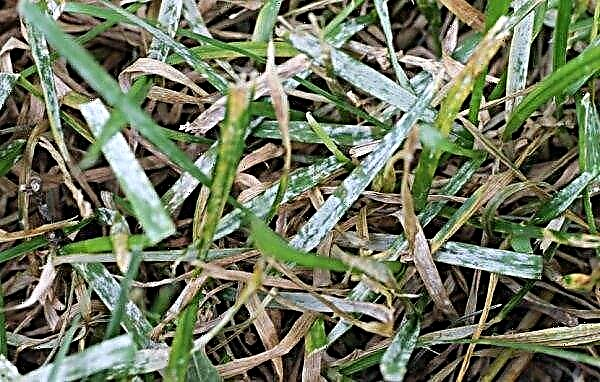Gladiolus is an unpretentious crop that is easy to grow in open ground. For crops, spring planting is preferred, which is associated with a number of nuances. To grow beautiful and healthy flowers, you need to consider all the subtleties. Read more about how to properly plant gladioli in the spring.
Planting bulbs of gladioli in spring
The culture is planted when the soil layer at a depth of 10-12 cm warms up to +8 ... + 12 ° С. Dates in different regions differ due to the climate. Recommended months for planting are shown in the table below.
| Region | Landing time |
| Southern areas | Beginning of april |
| Middle lane | End of April - beginning of May |
| Siberia and the Urals | The end of May - the beginning of June |
In addition to landing time, other nuances are important. These include tillage and bulbs, planting technology and further care.
Did you know? Title «gladiolus» comes from the Latin gladius - “sword”. This is due to the fact that the leaves of the plant resemble a blade of a blade.
Soil preparation
Before planting gladioli, decide on the landing site. The ideal soil for culture is sandy loam, loam or chernozem with acidity pH = 5.5–6.5. However, you can grow plants on all types of soil, if you previously prepare the site.

Pre-treatment is carried out in the fall, six months before planting. Preparation depends on the type of soil and consists in the introduction of neutralizing substances.
| Priming | What to deposit |
| Heavy clay | Sand and peat |
| Sandy | Peat |
| Peat | Sand |
| High acid | Lime (100-200 g per 1 m² of land) |
Further, also in the fall, for all types of soil, mandatory preparation measures are followed:
- digging the earth to a depth of 0.5 m;
- weed removal;
- application of nitrophosphate (30 g per 1 m² of plot).
Important! Black earth is rich in natural substances, so you can not fertilize it with nitrophos.
Pre-planting
Before planting tubers, planting material is sorted. Rotted and dry specimens are thrown away, and healthy ones are cleaned of the upper scales. Then the bulbs are treated with a nutrient mixture. One of the effective tips is to dilute a tablet of succinic acid in 1 liter of water and soak the planting material in this solution for 5 hours.

After processing, the tubers are laid out with their roots down and dried in the sun or in a room with an air humidity level of up to 50%. In this position, the planting material is kept until the roots on the bulbs grow to 2 cm. The last stage is the preventive treatment of the fungus. For this, the bulbs must be etched with Fitosporin. 10 g of powder is diluted in 0.5 l of water and the planting material is left in the resulting solution for half an hour.
Landing
To plant on the selected site make ridges with a depth of up to 15 cm. The distance between rows should be approximately 20 cm. Fitosporin solution prepared at the rate of 5 g per 10 l of water is poured into each furrow and sand is covered with a layer of 2 cm. The optimal distance between tubers is 15 cm.

Recommendations regarding planting depth depend on the type of soil:
- chernozem or sandy soil - 15 cm;
- swampy or clay soil - 8 cm;
- other species - 10 cm.
Feeding, watering and cultivating
Sprouts of gladioli appear about 15 days after planting. From this moment, they begin to care for the plants. Gladioli are watered once a week. Water is poured under the stem so that the soil is saturated with moisture by 2 cm. The soil is moistened in the evening so that the plant does not receive burns from exposure to water and sunlight. After each watering, the soil should be loosened. Otherwise, the earth will be taken up by the crust, which will impede the access of oxygen to the roots. Also, plants are fed with fertilizers.
Important! Fresh manure is not suitable for feeding, as it is a favorable environment for the growth of bacteria and fungal spores.
During the growing season, 3 dressings are made according to the following rules:
- when the first leaves appear - 25 g of ammonium nitrate per 1 m²;
- after the appearance of 5 sheets - 10 g of ammonium sulfate, 10 g of potassium sulfate and 15 g of superphosphate per 1 m²;
- before flowering - 30 g of superphosphate and 15 g of potassium chloride per 1 m².

Garter and Hilling
Gladioli have stems half a meter high and large peduncles. So that the plants do not fall under the weight of the buds, the flowers are tied up and spud. When the gladioli bloom, the plants need to be tied up. To do this, drive a stake near each flower and tie the flowers with a rope or a long strip of fabric. A more convenient option is to install the trellis along the row and pull the string, which will support the peduncles.
After blooming of the 5th leaf, the plants begin to spud. The base of the stems is piled with soil to a height of 8-12 cm. Hilling is carried out as the plant grows. In addition to support, this procedure insulates the root system of gladioli and promotes active growth.
Protection against diseases and pests
Gladiolus susceptible to fungal diseases such as fusarium, sclerotinia and gray rot. The fungus can be identified by the appearance of spots and rotting areas on leaves, flowers and stems. As a preventive measure, plantations are treated with fungicides every 15–20 days.

It is recommended to alternate spraying:
- "Fundazolum" (1 g per 1 liter of water);
- 0.5% copper chloride solution;
- potassium permanganate (3 g per 10 l of water);
- 1% solution of Bordeaux fluid.
Did you know? In the Middle Ages, crushed gladiolus tubers were added to wheat flour when baking bread.
Thrips are also dangerous for gladioli. These are long dark insects that lay larvae and feed on plant juice. To cure the plant, spraying the plantings with Fitoverm is carried out. To do this, 8 ml of the drug is diluted in 1 liter of water and treated with a solution of flowers at the rate of 1 liter per 10 m². Spraying is carried out 3 times during the growing season and flowering with an interval of 14 days. The drug begins to act within a day after treatment.

Recommendations and tips for planting in the spring
Experienced gardeners advise to observe the temperature regime during spring planting. In insufficiently warmed soil, planted bulbs will freeze and die. Be sure to pickle the bulbs and the ground with “Fitosporin” - then the processed planting material and ridges practically do not undergo diseases and take root better.
Many gardeners are trying to preserve dried and withered tubers. However, lesions of the bulb indicate a fungal disease, so it is better to throw away such planting material. The exception is tubers stored at high temperature. Bulbs that have dried up for this reason are soaked before planting in a soda solution (1 tsp. Per 1 liter of warm water) for 2-3 hours, and then dried. After that, you can safely plant the material in the soil.

To properly plant gladioli in the spring, you need to take into account the timing, preparation features and planting technology. Gardeners should always consider site characteristics, soil type and climatic conditions. Plant care is also important, which is carried out according to the recommendations described above. With the right approach, the plantings will delight the gardener with incredible flowering for a long time.












